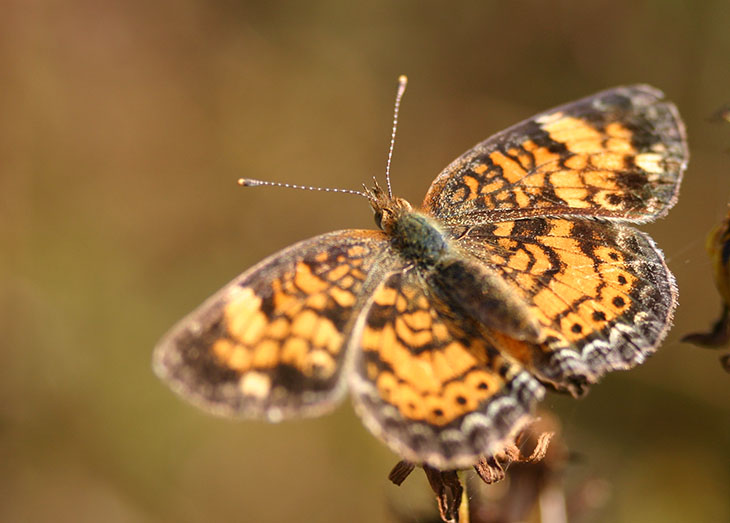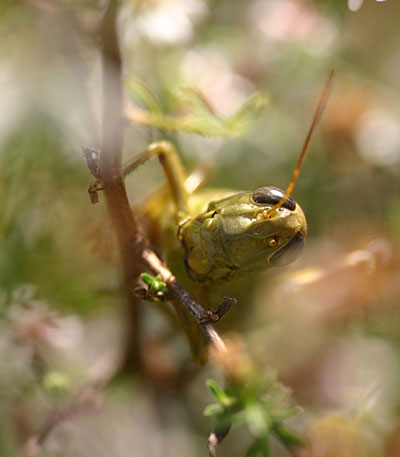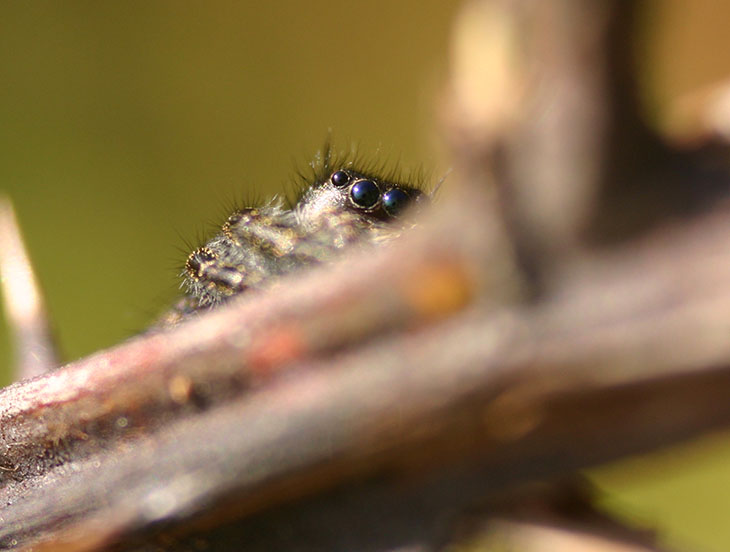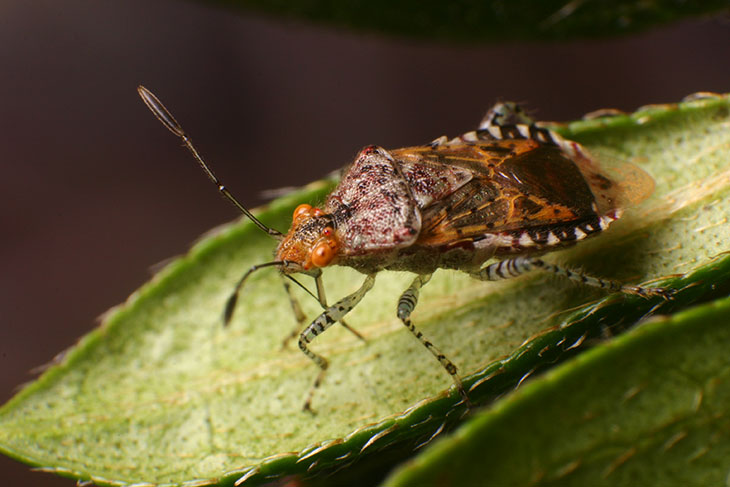
The weather has been spastic as all git-out, and I’ve actually postponed meetings with a couple of students because it’s been raining frequently and unpredictably, despite many meteorologist’s claims otherwise. Yesterday as the weather cleared I got out to a park that I don’t visit too often, having left early to beat the rush hour traffic, and had some time to kill before the appointment. It’s closing in on the end of the insect season here, and the trees are shedding their leaves fitfully.
 I didn’t assemble the dependable macro lighting rig, since it creates a large apparatus that cannot fit in any bag and takes a couple minutes to break down, so I amused myself with shooting macro in natural light, wide open at f4. You can see the effect this has above on what is probably a pearl crescent butterfly (Phyciodes tharos) – while measuring maybe 3cm across the wingtips, most of the specimen isn’t in focus at all. When restricted in this way, you can always select a perspective that works with such a short depth-of-field, such as the one at right. The grasshoppers were everywhere, and this one peeked up at me from among the flowers, one of the few that held still at my stealthy (okay, not terribly) approach. Nothing but the eyes had to be in focus, and in fact, not even all of the eyes, so this view from the blunt end seems to work for me. Not everyone is going to agree with my approaches towards images or composition, and that’s fine – there’s no right way to do it, and style is a matter of preference. So is what is about to come, which is inadequate warning that we’re going in for the serious closeups of even more icky things.
I didn’t assemble the dependable macro lighting rig, since it creates a large apparatus that cannot fit in any bag and takes a couple minutes to break down, so I amused myself with shooting macro in natural light, wide open at f4. You can see the effect this has above on what is probably a pearl crescent butterfly (Phyciodes tharos) – while measuring maybe 3cm across the wingtips, most of the specimen isn’t in focus at all. When restricted in this way, you can always select a perspective that works with such a short depth-of-field, such as the one at right. The grasshoppers were everywhere, and this one peeked up at me from among the flowers, one of the few that held still at my stealthy (okay, not terribly) approach. Nothing but the eyes had to be in focus, and in fact, not even all of the eyes, so this view from the blunt end seems to work for me. Not everyone is going to agree with my approaches towards images or composition, and that’s fine – there’s no right way to do it, and style is a matter of preference. So is what is about to come, which is inadequate warning that we’re going in for the serious closeups of even more icky things.

On the clusters of wildflowers found at the edges of the lake, various hymenoptera were quite active gathering nectar, and by extension pollen. This bumblebee originally fled in panic as I came in too close, but its panic wasn’t enough to send it very far, only dodging out from under my looming presence to the adjoining flower patch not a meter away, and this time I leaned in close while it was on the far side of the blooms. As it rose into view I was ready, and the bee’s protective response wasn’t triggered by proximity, only approach – I could be that close as long as I wasn’t getting closer; it could get closer, but that was its own movement and didn’t count within the algorithm that spelled “trouble” in its brain. The image illustrates why natural light macro work can be difficult, and especially why it shouldn’t be tackled in bright conditions, even when it might seem this is a good time to do so. While the entire head is black, it runs the full dynamic range of the image, blown out to pure white in the reflected highlights and dropping into Stygian darkness in the shadows (gotta love that word – if I ever have a kid I’m going to name him or her “Stygian.”) It was only through blind luck that the exposure setting for the camera fell where it did, otherwise it could have been even worse, but I still like the texture that came up on the head.

A slightly better approach was taken with this shy jumping spider, one of many visible throughout the brush if one looked closely. Here the sun’s position was just a little more behind me, illuminating more of the eyes, bringing up that blue-black color in contrast with the rest of the spider. I’m not perfectly sure, but I believe those black ‘pupils’ really are the retinas of the spider – close examination of the original image does not seem to indicate that they’re a reflection of the camera or anything else. The defocused briar in the foreground helps communicate the apprehensive appearance of the spider, as do the tucked legs, and in this case the impression is entirely accurate, at least if the spider’s behavior was any indication. We both dodged back and forth for these images, but I suppose it’s possible the spider was observing me and trying to remain inconspicuous…
For this next find, however, I was forced to dig out the flash, though I kept it simple and used it mounted on the hot-shoe – this still provides direct light that doesn’t model shapes as well, but at least I had a diffuser over the head to soften the contrast a little.

In the seed pods of the same hibiscus flowers seen here, some remarkably-colored hemiptera were digging away. The lack of wings pegs these as nymphs, and the orange bits are their heads and eyes. I knew I was only going to get so much detail in these conditions, so I got out a film can and collected a few specimens to tackle under better control, after the meeting with the student. This also required trying to determine what exactly they were, which was a little tricky. Their body shape was almost identical to broken-backed bugs, so I began searching within the family Miridae, yet that wasn’t turning up anything. Changing Google gears eventually led to this page and provided the exact species – my thanks to Lisa at the Virginia Living Museum!

Niesthrea louisianica do not appear to have a recognized common name, though I imagine regionally they might be called anything. Their coloration is what prompted the post title (were you wondering when I was getting to that, or do you ignore those anymore?) through the resemblance to both candy and gaudy makeup. This one is an adult, as betrayed by those wings, and imaged here on a stalk from the ever-useful azalea bushes. The fun of identifying species is demonstrated by all this, because despite their close resemblance to broken-backed bugs, these are a distant relation, coming from a different superfamily (in this case, Coreoidea.) If you look closely, you’ll see that my specimen paused for a drink from the main stem of the azalea leaf, its proboscis extending down from the tip of its head. This inactivity (after many attempts to stay on the dark side of the leaf, which obviously presents some difficulty in macro photography) helped me to get some images I’ve been after for a couple of months.

Is this close enough? In images of another species from this summer, I realized that the proboscis was not a single probe, but separate body parts working together. The pale, jointed portion is (I believe) the labium, used for cutting into the plant down to the juicy bits – or, in the case of the insectivorous hemiptera, cutting into the prey as well. The needle closest to us extending down past those joints is the combined mandible and maxilla, what we humans call our lower and upper jaws, but here they serve the purpose of injecting saliva and drawing up sustaining fluids. They can pull entirely free from the labium but this isn’t often seen. I would have tried to provoke this action just to get an image of it, but there were a few reasons not to. Realize that the overall length of this insect here is just 9mm, and the head itself is 1mm. See how the foreleg, the antennae, and the shoulder plastron are all out of focus? That means my effective sharp focus range was also about a millimeter. While I could potentially have affixed the camera to a tripod, since the N. louisianica was now holding still, I was at the time working handheld. Even with the leaf in a clamp, I had to hold still at a precise distance from my subject, unable to move more than a millimeter forward or back – and then I would have had to provoke the bug into disengaging from its meal, and capture the exact moment when the mandible and maxilla withdrew from the labium. Obviously the chances of this were slim, and I would have had only one shot at it, since convincing the bug to go back to feeding would be problematic at best. I hope you can understand why I did not inflict the frustration upon myself.
Oh, yeah, I should clarify something else too. You recall above where I said I was shooting in natural light at f4? Of course, shooting at a smaller aperture would increase the depth-of-field and thus improve focus, but that reduces light and requires a supplemental flash (or slower shutter speed, and hopefully the reasons to avoid that are obvious.) But DOF also reduces with higher magnification, and I was using an entirely different lens for the bottom shots; those images were shot with the reversed 28-105mm at 28mm, at f16, with the softboxed flat-panel strobe. It wasn’t getting any better than this.
















































